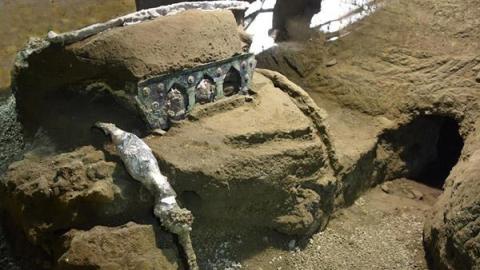Researchers unearth the “Lamborghini” of ancient chariots in Pompeii

Credit: Luigi Spina, Archaeological Park of Pompeii
- Archeologists recently discovered a first-of-its-kind chariot in Pompeii.
- The ceremonial chariot is decorated with bronze and tin medallions, while the sides sport bronzesheets and red-and-black paintings.
- Given looting activity in the area, it’s lucky the 2,000-year-old treasure wasn’t lost to the world heritage site.
In 79 CE, near the Bay of Naples, Mt. Vesuvius erupted. Geologically, this was business as usual for the volatile volcano, but for the nearby cities of Pompeii and Herculaneum, it proved a cataclysmic event.
After the terrifying initial blast, the volcano spewed ash and rocks miles into the atmosphere. As this volcanic drift cooled, it began to snow onto the cities. It collapsed buildings under its weight and suffocated those unlucky enough to not flee. Then came the pyroclastic flows—massive waves of ash, gases, and lava fragments that washed over the cities at speeds of more than 100 miles per hour. All told, Vesuvius unleashed more than 100,000 times the energy of the two atomic bombs dropped during World War II on doomed towns nestled beneath it.
It seemed as though the cities weren’t simply wiped off the map but practically from history itself, banished to a footnote in historical text. And so when explorers in the 1700s found the super-heated ash had preserved the city with taxidermic care, it was a miraculous discovery.
Today, Pompeii’s fossilized slice-of-life gives historians an unprecedented view into a moment of history and culture. Bodies lie where they lived, traces of their clothes and other belongings still clinging to their forms. Frescos retain their imagery and vibrant colors. Fast food joints (called thermopolium) can be found with the jars still holding remnants of their menu items. Even the brain cells of a young man managed to survive the ages in vitrified conservation.
Each excavation teaches us something new about life in this Roman resort town, and Pompeii continues to surprise archeologists and historians well in the 21st century.

Researchers carefully extract the chariot from the sedimentary rock encasing it.Credit: Luigi Spina, Archaeological Park of Pompeii
In a recent discovery, researchers unearthed a first-of-its-kind chariot at Civita Giuliana, an excavation site north of Pompeii’s ancient walls. In Roman times, the site served as a getaway for Rome’s elite and wealthy citizens, a serene countryside brimming with villas and Mediterranean farms. So, it’s understandable why such an exquisite chariot was found here.
“I was astounded,” Eric Poehler, a professor at the University of Massachusetts Amherst, who specializes in Pompeii traffic, told NPR. “Many of the vehicles I’d written about before … are your standard station wagon or vehicle for taking the kids to soccer. This is a Lamborghini. This is an outright fancy, fancy car.”
Located in a double-level portico, the chariot is a far cry from anything Ben-Hur would have been seen cruising around in. It sports four iron wheels and a high seat complete with arm- and backrest. The sides are adorned with engraved bronze and wooden panels painted with red-and-black figures. And the rear bumps with a register of bronze and tin medallion depicting Eros-inspired scenes of satyrs, nymphs, and cupids. In short, this chariot is slab.
“It is an extraordinary discovery for the advancement of our knowledge of the ancient world,” Massimo Osanna, the director of the archaeological park, said in a statement. “At Pompeii vehicles used for transport have been found in the past, […] but nothing like the Civita Giuliana chariot.”
But unlike a Lamborghini—which serves only to show the owner has more money than sense—this chariot served a social and cultural role. Likely a pilentum, it would have been rolled out in times of ceremony, potentially during festivals, processions, or weddings.
While similar chariots have been uncovered in northern Greece, this is the first such chariot to be discovered in Italy. Its presence in Pompeii will further help historians understand the people who called the city home, as well as their relation to the Mediterranean world.
As Poehler added, “This is precisely the kind of find that one wants to find at Pompeii, the really well-articulated, very well-preserved moments in time. And it happens to be in this case an object that is relatively rare despite its ubiquity in the past.”

Bronze and tin medallions depict satyrs, nymphs and cupids.Credit: Luigi Spina, Archaeological Park of Pompeii
Beyond its gilded appeal, the chariot is also special because it survived so we could learn from it. The area where the vehicle was found has been favored in recent years by looters, and illicit tunnels had been dug precariously close to the chariot’s resting place. For this reason, the archeological park has teamed up with the Public Prosecutor’s Office of Torre Annunziata to protect Pompeii’s history and excavate its treasures before they become lost or stolen.
“The collaboration between the Public Prosecutor’s Office of Torre Annunziata and the Archaeological Park of Pompeii has proved itself to be a formidable instrument, not only for bringing finds of exceptional historical and artistic value to light, but also for halting the criminal actions of individuals who for years have been the protagonists in a systematic looting of the priceless archaeological heritage preserved in the vast area of the Civita Giuliana villa, which is still largely buried and to which the recent exceptional findings bear witness,” Nunzio Fragliasso, chief prosecutor of Torre Annunziata, said in his joint statement with Osanna.
Nor is everything that glitters historic gold. Even Pompeii’s everyday ephemera can have an outsized impact on history. Pompeian citizens, for example, viewed street walls as a type of “public advertisement space” and so painted them thick with graffiti. As historians must often rely on the written works of the literate elite, this graffiti gives the ordinary Pompeians their voice back. One such charcoal tag even corrected the record of Vesuvius’s eruption by two months, from August to October, contradicting the traditionally accepted date set by Pliny the Younger.
“Today, archaeologists try to understand ancient societies by studying the entire material record — not just the beautiful or luxurious objects, but also the broken bits of cooking pottery, the animal bones thrown into the trash, the microscopic grains of pollen in the soil, and much more,” Caitlín Barrett, associate professor at Cornell University, told CNN.
This ephemera is also at risk. Looters looking for eye-catching treasure and artwork will often destroy everyday objects in their pursuit. And after centuries encased in protective sedimentary rock, the city has again been exposed to the rains, winds, and human blunders that erode. The goal now isn’t just to excavate fantastic treasures, but to preserve the world heritage site and learn from it for as long as time (and maybe Vesuvius) will allow.





